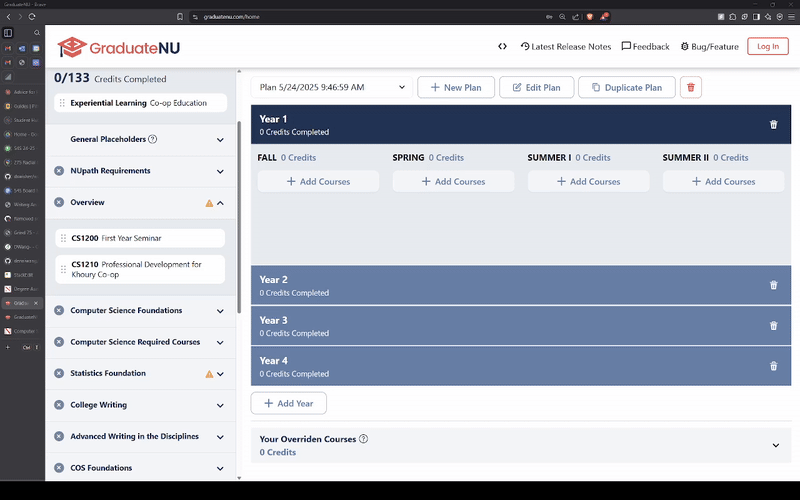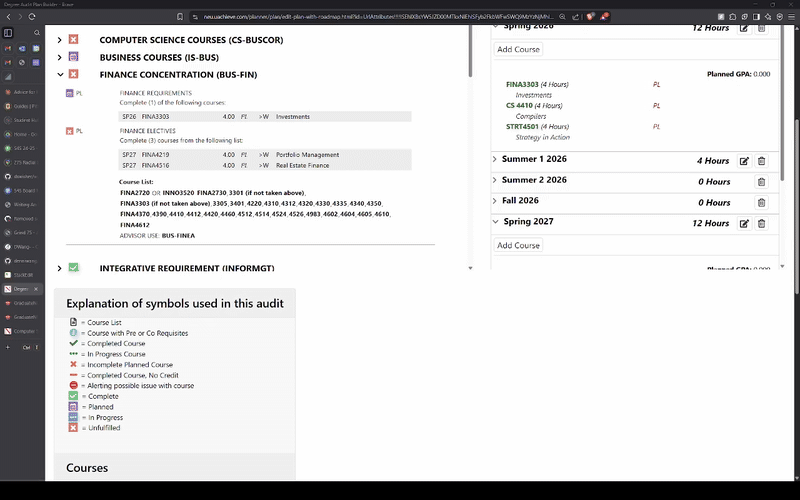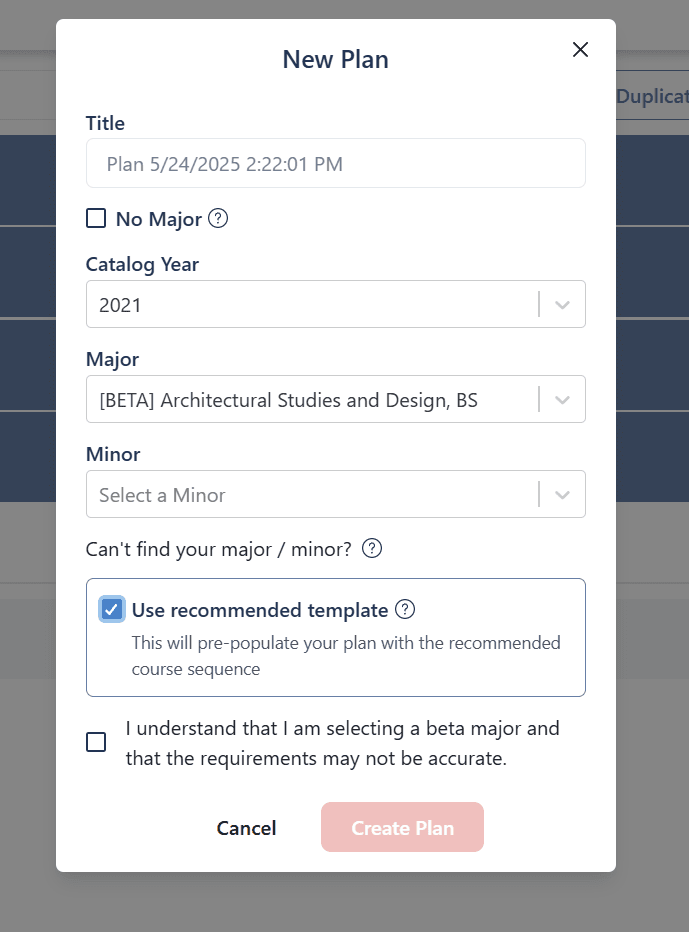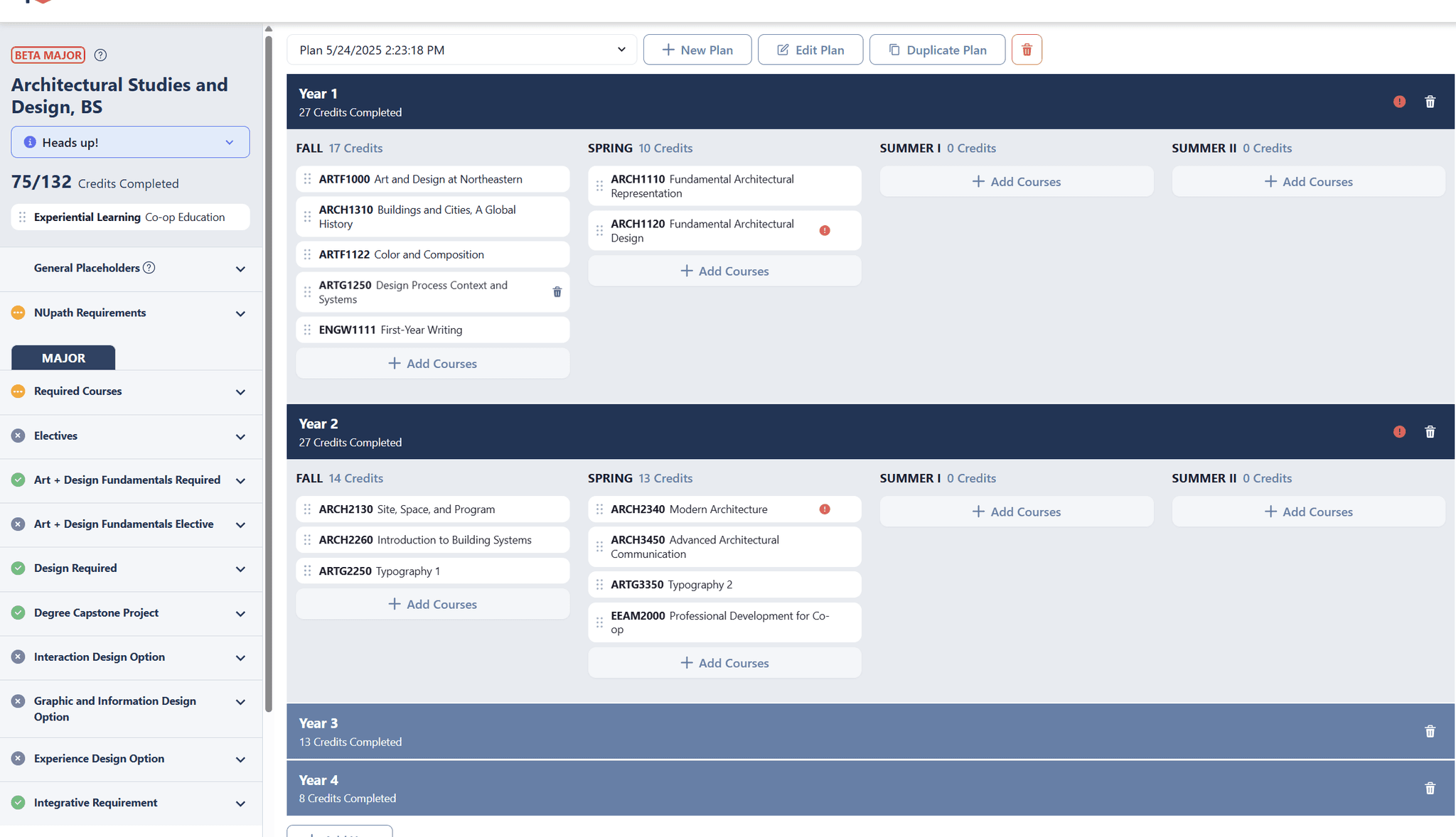The Problem That Started It All
Picture this: you're a freshman at Northeastern, staring at a blank degree audit system, wondering how you're supposed to navigate four years of coursework without losing your mind. You open UArchieve, Northeastern's official degree planning tool, and immediately hit a wall. The interface feels like it was designed in 2005, course validation takes 10+ seconds per change, and figuring out what classes you actually need feels like solving a puzzle with half the pieces missing. This was my reality before I discovered there had to be a better way.
Finding My Purpose at Sandbox
I joined Sandbox @ Northeastern in the fall of 2024 because I wanted to apply my React experience to something that actually mattered. I was tired of building todo apps and portfolio sites that only I would ever use. I wanted to create something that would genuinely improve students' lives, something that solved a real problem I experienced myself. That opportunity manifested itself in the form of GraduateNU, Sandbox's answer to Northeastern's painfully unintuitive and slow degree audit system. When I first heard about the project, I knew this was exactly the kind of impact-driven work I'd been searching for.
Building Something Students Actually Want to Use
The difference between GraduateNU and UArchieve isn't just technical—it's philosophical. While UArchieve treats degree planning like a bureaucratic checkbox exercise, we designed GraduateNU around how students actually think and plan.

Our platform offers an immediately intuitive user interface that gives instant feedback. When you drag a course into a semester, you know immediately whether it counts toward your requirements. No waiting, no second-guessing, no confusion. We also built in the ability to easily switch majors, concentrations, and minors while keeping your entire plan intact, so students exploring different academic paths can compare options side-by-side without starting from scratch. The drag-and-drop functionality might look similar to UArchieve on the surface, but the devil is in the details. Our layout prioritizes getting all your information on a single screen, with powerful search functionality that actually helps you find the courses you need. Every design decision was made with the student experience in mind.
Speed That Actually Matters
The performance difference is staggering. While UArchieve forces you to wait 10+ seconds to validate any change to your plan, GraduateNU validates changes instantly as you make them. We don't batch validation requests or rely on slow external APIs—we built our system to have all the necessary data for major requirements directly in the app.

This architectural decision means we're not dependent on intermediary services between our frontend and backend. When you move a course, the validation happens immediately because all the logic and data are already there, waiting. It's the difference between having a conversation and waiting for letters in the mail.
Building Trust Through Transparency
The most important question students ask us is: "How can I trust this site with my academic future?" It's a fair question, and one we take seriously. We scrape degree, concentration, minor, and template plan requirements directly from the Northeastern Academic Catalog, the same official source that UArchieve uses. The difference is in how we present and validate that information. We're still rigorously testing our validation algorithm across all 400+ majors because we know that even small mistakes can have big consequences for students. If you spot any discrepancies, we've made it easy to report them through our feedback form or by emailing me directly at wang.yicheng4@northeastern.edu. We're committed to continuous improvement because we know this tool is only valuable if it's accurate.
My Deep Dive: Template Plans That Actually Help
The feature I'm most proud of working on is template plans. Here's the thing that many students don't know: alongside every major, Northeastern's degree catalog includes suggested four-year roadmaps. These plans account for different co-op schedules and provide a clear pathway from freshman year to graduation. The problem? They were buried in the catalog where most students never found them. I saw an opportunity to surface this hidden treasure. We already had an impressive scraping system pulling requirements for 400+ majors, and I realized the template plans were just one URL modification away. What seemed like a straightforward addition turned into a fascinating technical challenge. After identifying the template plan pages, I saved sample HTML files and worked with Claude to develop a parsing framework. The raw HTML was messy and inconsistent, but through several iterations of testing and algorithm refinement, I cracked the code. What started as chaotic web pages became clean, structured data:
"Sample Four Years, Two Co-ops in Summer 2/Fall": {
"Year 1": {
"Fall": [
"ARTF 1000",
"ARCH 1310",
"ARTF 1122",
"ARTG 1250",
"ENGW 1111"
],
"Spring": [
"ARCH 1110",
"ARCH 1120"
]
},
"Year 2": {
// ... continues for all four years
}
}The real magic happens on the frontend. Students can now click a simple checkmark to instantly populate their entire four-year plan with their major's recommended template. No more staring at blank semesters wondering what comes next.


Ending note
Ready to experience degree planning that actually works? Check out GraduateNU or our sister project SearchNU. Found a bug or have feedback? Let me know at wang.yicheng4@northeastern.edu or fill out our feedback form.